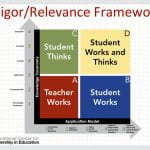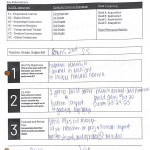A Habitat in Quad D
Each lesson plan that is well thought out will most likely start with the state standards. This week’s lesson will focus on habitats, for example. If you are an educator in Virginia, your plans might start with
This is a great starting point. You know where you need to go. In this example the students are learning about habitats and how they’ve changed over time. How will you get there? Thinking back to Quad D, which is learning that is characterized by high academic rigor as well as the application of knowledge to solve real-world problems (The Center for Model Schools), the goal is to have the students think on their own. Traditionally speaking, we can surely find a worksheet or website that will ask our learners to state the information they know. During the time you are teaching the unit, the information can be reiterated and marked correctly on a test. For the time being, the goal has been met. A child can name a habitat or reasons why it has changed. In six months can they answer the same questions? Did they truly learn the standard or just enough to get the score?
Quad D, which is learning that is characterized by high academic rigor as well as the application of knowledge to solve real-world problems (The Center for Model Schools), the goal is to have the students think on their own. Traditionally speaking, we can surely find a worksheet or website that will ask our learners to state the information they know. During the time you are teaching the unit, the information can be reiterated and marked correctly on a test. For the time being, the goal has been met. A child can name a habitat or reasons why it has changed. In six months can they answer the same questions? Did they truly learn the standard or just enough to get the score?
This is a great time to partner with an instructional coach. You have both learned pedagogy and now add in the expertise of the questioner and planner. Together you can figure out how to marry both of your expertise so that the end result is students taking a deeper dive into a child’s learning living in a quad D quadrant. A few weeks back I sat down with a teacher with the same standard above and asked her “What can you tell me about your class? What are their strengths and obstacles?” Through this conversation we created a list that contained words like strong personalities, conversationalists, leaders, artists, coders and creative minds that led us to creating a group project. Fostering these real life skills while learning about animals homes will lead us to the educator understanding what your students need, their strengths, areas you would like them to grow , and connecting us all to real world skills.
As the teacher and myself laid out the outline for the project it began with the students completing a worksheet that guided them through research using Pebble Go and drawing a picture of their findings. Moving forward they needed to create a map where their images were combined into one and a coded road was created for an Ozobot to drive through it. As it drove through, the creators of the each habitat had to explain to the class the land, water and animals that would exist in that location.
You see, as we engaged in a conversation of pairing the habitat standard with the traits of her students the project grew and grew. At some point while working on the project all of the individual students’ interests were tapped into allowing each one to shine. Did we, as a whole group, have bumps along the way? You bet! Can you name a group project that doesn’t have them? However the information learned along the way is exactly what was needed from the Science standard listed above to the social emotional components, public speaking skills and collaborative work that will lead the class to success.

